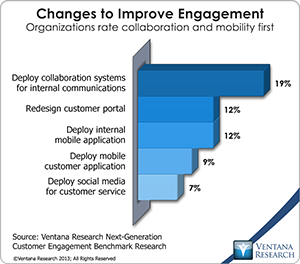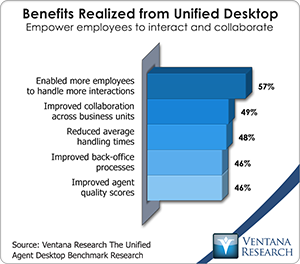Customer Experience was one of the subjects most talked and written about during 2014, and I expect this to continue in 2015. Many observers and analysts, including me, believe it can be the difference between companies succeeding or going out of business. Yet debate continues to define what customer experience is and how to manage it. Some think the best tools are “voice of the customer” information and systems that enable companies to track and understand customer sentiments and likely actions. Others advocate customer or interaction analytics that provide a complete view of the customer. For others it is all about social media and how it changes the customer relationship, and many diehards still insist customer relationship management (CRM) systems are the key. Indeed, as it is with CRM, ask 100 people what it is and you may get 100 different answers. I go back to basics. For me the customer experience is how customers feel and act during and after any engagement with a company. Of course, there are many ways of interacting these days, whether it is seeing an advertisement, receiving an email, talking to an agent in a call center, having a service engineer visit your house, looking for answers on a company’s website, trying to navigate through IVR menus, using the company’s mobile app or watching a YouTube video. These all impact customers’ perceptions of a company, affect their emotions and drive their reactions. In all, the customer experience is determined by the combination of how employees behave, how well processes work, how complete the information about the customer is and the impacts of diverse types of systems, all of these at any point of engagement throughout the customer life cycle.
I recently shared some lessons I learned about the customer experience during 2014. One is that customers want EPIC (easy, personalized, in-context and consistent) experiences. This provides a starting point for further thought about the technologies that are likely to impact customer engagement most during 2105.
My benchmark research into next-generation customer engagement  provided insights into what kinds of systems companies believe will help them improve customer engagement over the next 24 months. The most often mentioned is a collaboration system in which employees can work together on resolving customer issues. This and other research confirms that today almost every business unit within an organization engages with customers; however, not all of them have the skills and access to the right information to resolve issues at the first attempt – something that customers have come to expect. Modern systems with Facebook-like posting capabilities facilitate sharing of information and collaborative effort. Three of the next four most often mentioned – redesign the customer portal, deploy mobile customer service apps and deploy social customer service – support the trend toward self-service, but customers want self-service to be much easier than it has been up to now. Specifically they want websites that go beyond FAQs to become natural-language-based Q&A sessions. They want mobile apps that work in ways they are used to, and if they don’t work, they want to connect immediately to a person who can help them. They want social media to go beyond marketing videos and messages to actually help them resolve their issues. Companies also plan to deploy mobile apps internally to help employees access customer information and systems on their smartphones and tablet so they can help resolve issues without having to wait until they are back at their desks.
provided insights into what kinds of systems companies believe will help them improve customer engagement over the next 24 months. The most often mentioned is a collaboration system in which employees can work together on resolving customer issues. This and other research confirms that today almost every business unit within an organization engages with customers; however, not all of them have the skills and access to the right information to resolve issues at the first attempt – something that customers have come to expect. Modern systems with Facebook-like posting capabilities facilitate sharing of information and collaborative effort. Three of the next four most often mentioned – redesign the customer portal, deploy mobile customer service apps and deploy social customer service – support the trend toward self-service, but customers want self-service to be much easier than it has been up to now. Specifically they want websites that go beyond FAQs to become natural-language-based Q&A sessions. They want mobile apps that work in ways they are used to, and if they don’t work, they want to connect immediately to a person who can help them. They want social media to go beyond marketing videos and messages to actually help them resolve their issues. Companies also plan to deploy mobile apps internally to help employees access customer information and systems on their smartphones and tablet so they can help resolve issues without having to wait until they are back at their desks.
From these initial insights I developed a conceptual architecture that I believe is required to deliver EPIC experiences, and I used it in a webinar I gave about the three waves of customer experience. It includes six key technical components, all of which I will be following in 2015:
- Integrated multichannel communication infrastructure. These systems manage multiple communication channels, including assisted channels such as voice, email and chat, and self-service channels such as customer portals, mobile apps, social media and virtual agents, and manage them in a connected way, including the capability to route interactions based on a single set of customer-related rules. Several vendors provide such systems, all of them cloud-based systems; they include 8X8, Corvisa, Enghouse Interactive, Genesys, inContact, Interactive Intelligence, NewVoiceMedia and Verint/Kana.
- Analytics. You can’t provide EPIC experiences unless you fully know your customers, and to do that requires advanced analytics. The key in choosing a system is the number and types of data sources the analytics works on; the more it uses, the fuller the customer view. The volume and diversity of data sources thus puts customer and interaction analytics in the big data arena, and companies should look for systems that process every form and high volumes of interaction and transaction data. A diverse set of vendors provides customer or engagement analytics, including IBM, Nexidia, NICE Systems, Salesforce.com, SAS, Transera and Verint.
- Smart agent desktop. Handling customer interactions has become complex. Contact center agents and other employees handling interactions have to access multiple
 communication channels, business applications, notice boards and dashboards, and the process varies depending on the customer and the type of interaction. My research into the agent desktop and customer service shows that the most advanced companies have deployed smart agent desktop systems that make the process more consistent, efficient and effective. Vendors providing such technology include Cicero, Jacada, ManyWho, NICE Systems, OpenSpan, Panviva and Salesforce.com.
communication channels, business applications, notice boards and dashboards, and the process varies depending on the customer and the type of interaction. My research into the agent desktop and customer service shows that the most advanced companies have deployed smart agent desktop systems that make the process more consistent, efficient and effective. Vendors providing such technology include Cicero, Jacada, ManyWho, NICE Systems, OpenSpan, Panviva and Salesforce.com.
- Business applications. A diverse set of business applications is required to deliver EPIC experiences. They include workforce optimization to manage the people handling interactions; customer feedback or voice of the customer systems to collect and analyze customer opinions; CRM systems to manage customer-related activities and transactions; accounting systems to manage the financial side; and others. A variety of vendors offer some or all of them.
- Collaboration. As mentioned above, the most advanced companies have deployed collaboration systems so that more than one employee can work on resolving an interaction and employees can share information more easily. I expect this trend to increase during 2015. With it will come the dilemma of whether to choose stand-alone systems such as are available from Cisco, Interactive Intelligence and Salesforce.com, or business applications that have such capabilities built in. Regarding the latter, our 2015 Value Index on Workforce Optimization shows that vendors are not yet advanced in adding collaboration.
- Mobile apps. About 18 months ago there was a flurry of announcements from vendors pitching systems to support building mobile apps. This seems to have died down, and my research into next-generation customer engagement conforms that such products are not being widely adopted yet. However, I expect this to change during 2105 as more consumers demand apps on their smart devices so they can self-serve while on the move. Vendors such as Genesys, IBM, Interactive Intelligence, NICE Systems and Salesforce.com offer systems to help build such apps.
As I explained in my 2014 lessons learned perspective, managing the customer experience is not easy. It involves almost everyone across the enterprise, multiple processes and multiple systems for communications, business and analytics. To get it right you need to think four dimensions: where each customer is in the customer life cycle (researching, buying, using or seeking support), who in the organization is engaging with the customer, which channel of communication is being used for the engagement, and which product or service the engagement is about. At the same time you must keep track of tens of vendors. This year looks like it will be another challenging one as companies fight to win and keep customers. One thing we know is that the customer experience will be the key differentiator. So please connect with me at @rjsnowvr or on LinkedIn at http://uk.linkedin.com/in/richardjsnow to share your views and keep track of developments.
Regards,
Richard J. Snow
VP & Research Director











